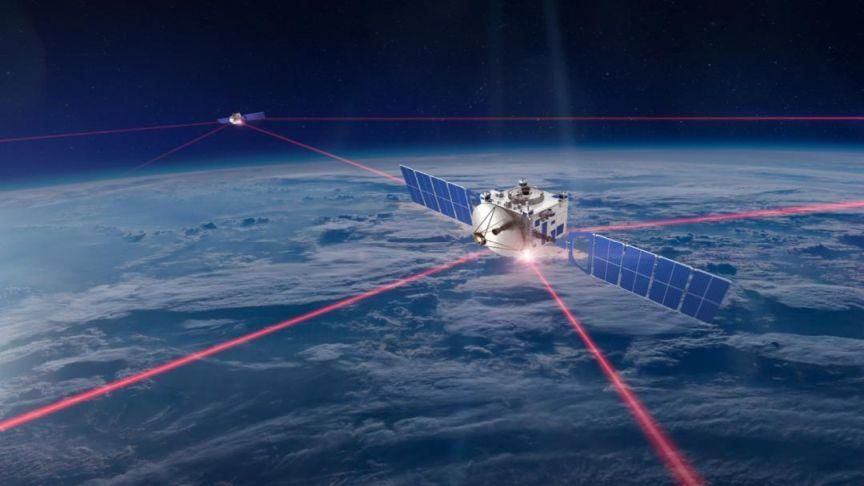By Eric Vandenbroeck and co-workers
On February 26, 2022,
two days after Russia launched its full-scale invasion of Ukraine, Mykhailo Fedorov,
Ukraine’s minister of digital transformation, sent an urgent plea to Elon Musk
to provide Internet access to the country through his Starlink system. The invasion, which Russia had
preceded with a campaign of cyberattacks, had seriously disrupted Ukraine’s
digital networks. By the very next day, Musk responded that Starlink was active in Ukraine and that the
company would soon be sending more ground terminals to the country.
Starlink, which is a
subsidiary of Musk’s SpaceX, was not the only
Western technology company to come to Ukraine’s aid. By detecting
samples of Russian malware before the war began, Microsoft had warned Ukraine
about how the impending conflict could affect the country’s information
systems. Amazon Web Services (AWS) and Microsoft then migrated crucial
government data to their cloud servers for safekeeping, and after the war
began, Google and Microsoft offered continuing cybersecurity services. The
European aerospace conglomerate Airbus, the U.S.-based satellite manufacturer
ICEYE, and the space technology companies Capella Space, HawkEye
360, and Maxar Technologies have all been
providing invaluable battlefield imaging and data. The analytics company
Palantir has been aggregating this data to paint a more complete picture of the
war on the ground.
Although corporations
have long been involved in modern wars, their past roles have almost always
focused on the production of goods and equipment under government contracts. By
contrast, the conflict in Ukraine has initiated a new era of warfare in which
commercial companies, many of them American, are likely to provide and secure
critical digital infrastructure themselves—crucially, at their discretion and
even for no cost. For example, because of AWS and Microsoft’s
efforts to secure Ukrainian government data, Russia’s targeting of
data centers outside Kyiv at the start of the war failed to disrupt key
government services. Russia’s effort to deploy malware also had
little effect because of Microsoft’s intervention. And although Russia hacked Viasat, a U.S. company whose satellites were vital
to Ukrainian military and civil communications, Ukraine was able to pivot
within a few days to Starlink, on which President Volodymyr Zelensky relied for
nightly broadcasts to assure Ukrainians he was still in Kyiv and disprove
Russian misinformation that he had fled the country. Without such assistance
from Western companies, Ukraine’s government might have quickly collapsed. None
of these companies build weaponry; nonetheless, their ability to provide
crucial services in the digital realm has become what might be called warfare’s
new “commercial frontier”: essential battlefield capabilities that are
controlled and furnished by civilian technology firms.
Since the private
sector drives innovation in so many of these digital technologies and can
deploy them more nimbly than governments can, technology corporations are
likely to play an ever more important role in future wars. The challenge will
be ensuring that these companies’ interests are
aligned with national ones. In Ukraine, this alignment was largely due to
chance. Ukrainian leaders had developed close personal relationships with some
of the corporations that later came to the country’s aid. Moreover, Western
countries felt a sense of urgency to defend Ukraine and, crucially, anticipated
that the war would be short; the companies offering their services—mostly for
free—assumed that the costs of doing so would be low.

A Ukrainian soldier attending to a satellite in Kreminna, Ukraine
Future conflicts,
however, may have more complicated circumstances. One of the central
geopolitical unknowns of the present era is whether the United States would
defend Taiwan in the event of a Chinese invasion. But this question cannot be
answered by the U.S. government alone. In any such offensive, China’s plans
would almost certainly include attacks on Taiwan’s digital infrastructure,
scenarios that Beijing has already tested by launching cyberattacks and
severing Internet cables. Many of the same companies that protected
Ukraine will be needed to protect Taiwan. But many U.S. technology firms today
have a far greater economic stake in China than they
did in Russia in 2022, and it’s highly uncertain whether they would choose
to support Taiwan. Corporate leaders’ increasing involvement in global politics
and foreign policy will only add to this uncertainty. In October, for
instance, The Wall Street Journal reported that Elon Musk has
been in regular contact with Russian President Vladimir Putin since 2022; at
one point, Putin requested that Musk withhold Starlink access to Taiwan as a
favor to Chinese leader Xi Jinping. (It was not reported whether Musk agreed.)
Making matters even more complex, Musk is now a close adviser to President
Donald Trump and leads the administration’s government efficiency efforts.
Several other of the tech industry’s biggest names also joined Musk at Trump’s
inauguration. By seeking closer ties to the administration, the country’s
biggest tech firms may be trying to move national interests toward their own,
which may prioritize shareholder value more than national security.
The only way for the
U.S. government to ensure that its own interests are advanced at the commercial
frontier of warfare is to secure that frontier for itself. To do so, the
government must understand the capabilities needed to protect an ally’s digital
infrastructure during conflict and then seek to manage their use by
contracting the relevant vendors to provide their services under U.S.
governmental auspices. The government must seek to contract these new
capabilities before conflict breaks out, preposition these technologies’
physical assets in potential geopolitical hotspots, and begin to treat the
companies that are providing these services as allies. Only then can the United
States protect digital critical infrastructure in the wars in which it is involved,
whether directly or indirectly.

Corporate Deployment
In the early days of the
war in Ukraine, firms such as AWS, Microsoft, and SpaceX could not draw on any
previous experience of involvement in global conflict. And ultimately, their
actions were not spurred by grand strategies or government directives. They all
made quick decisions that were often based on direct contact with Kyiv or
Washington and that drew on favorable circumstances.
In the weeks leading
up to the war, Vadym Prystaiko, Ukraine’s then
ambassador to the United Kingdom, and Liam Maxwell, AWS’s director of
government transformation, discussed the idea of moving Ukraine’s data to the
cloud. Prystaiko, a former computer scientist, had
previously befriended Maxwell, a former chief technology officer for the
British government. On the day of the invasion, they sat together
and listed, with pen and paper, the essential data that would need
to be moved from government servers to the cloud, such as records
pertaining to land ownership, tax payments, and bank transactions. The massive
migration happened just before Russia attacked areas around Kyiv that house
critical data centers.

Corporate support for
Ukraine also relied on relationships with U.S. officials. Hours before the
invasion began, Microsoft uncovered a Russian malware attack on Ukraine’s
government ministries and financial institutions. During previous incidents,
Tom Burt, a senior security executive at Microsoft, had asked Anne
Neuberger, the White House’s senior cyber official, with whom he had a personal
relationship, to connect him to Ukrainian officials he could trust. When the
larger malware attack came, Microsoft had a direct line to Ukraine and was able
to quickly notify the country’s top cybersecurity authority.
The urgency of
Russia’s all-out invasion also created a special demand for corporate
involvement, because the private sector was better equipped than the U.S.
government to respond in real time. Big tech firms were able to
transfer huge quantities of Ukraine’s sensitive data almost immediately, with
AWS even delivering to Ukraine physical data-storage units known as Snowballs
to facilitate data transfers that would have taken too long to do over the
Internet. SpaceX activated Starlink in Ukraine just two days into the war. In
addition to covering all the initial service costs, SpaceX also paid to ship
enough terminals to meet Ukrainian demand from Southern California, where
SpaceX is based. “People were dying, and we thought we could be helpful in that
urgent phase of the conflict,” one SpaceX official later said. In contrast, it
took two weeks for the U.S. military to deliver its first supplies to Ukraine,
and some forms of military assistance took much longer. Major General Steven
Butow, the director of the Space Portfolio at the Pentagon’s Defense Innovation
Unit, said, “When we had delivered 25 things, there were already over 1,000
Starlink terminals being used every day.” Starlink has been described as “the
essential backbone” of Ukrainian battlefield communications.
The cost of all this
aid has become significant. To date, Microsoft’s support, which includes
hosting Ukraine’s data on its cloud for free, amounts to more than $500 million
worth of services. SpaceX spent more than $80 million on Starlink terminals and
services. The companies denied that financial interests played a
role in their decisions, but they also did not expect their involvement to last
as long as it has. At the start of the war, the
predominant view among the U.S. foreign policy establishment was that Ukraine
would lose and lose quickly. These companies had the same expectation,
but once it proved false some began to withdraw. Microsoft, for instance, still
provides the Ukrainian government with free cloud storage, but SpaceX
transferred the cost of Ukraine’s Starlink access to the U.S. government in
late 2022. The service became part of the United States aid package to Ukraine.
Some terminals have been provided by European allies, too.

The Fire Next Time
If Ukraine was the
technology industry’s initial foray into warfare, it won’t be the last. Yet in
future wars, many of the conditions that pushed corporate entities to deliver
massive aid to Ukraine may be different. For one thing, the
personal relationships that encouraged direct, fast communication between the
Ukrainian government and the big U.S. companies that could help it may not
exist. The corporations that mobilized for Ukraine were also acting on
decisions they had never anticipated making. They are far more aware of the
risk that conflicts can last longer than expected, that costs can accumulate to
significant levels, and even that overwhelming public support to help a country
in conflict can wane over time. As of December 2024, opinion polls
showed that for the first time, a majority of
Americans expressed a desire to end the war in Ukraine quickly, even if it
meant Ukraine forfeiting territory.
All these factors
will influence how the commercial frontier will play into what might be the
next big conflict: Taiwan. A Chinese invasion of the island would
likely start with a campaign to dismantle the Taiwanese government’s digital
infrastructure. In anticipation, Taiwan has discussed Starlink access with both
SpaceX and U.S. government officials. But Musk’s appetite for supporting Taiwan
through Starlink appears low. In 2023, he compared China’s relationship with
Taiwan to that between the United States and Hawaii, and
asserted that the island was an “integral part of China.” Taiwan is
wary of relying on Starlink access, as well, owing to Musk’s business links to
China, where Tesla operates several large factories and recently broke ground
on its first energy-storage plant outside the United States. As a result,
Taiwan has decided to partner with Eutelsat OneWeb, a European provider, and
discussed partnering with Amazon’s Project Kuiper, too. Neither has nearly as
many satellites or the same proven resilience as Starlink. Separately, Taiwan
has begun building its satellite network, though by its projections, it will
not have a communications satellite in orbit until at least 2026, and it will
take far longer to field the constellation of satellites needed to operate an
effective system.

SpaceX is not the
only company whose support for Taiwan is uncertain. Although AWS, Google, and Microsoft
have all significantly curtailed their operations in China, each continues to
rely on Chinese manufacturing and sells to the Chinese market. That these tech
firms will have potential conflicts of interest underscores the importance of
developing a U.S. strategy for the commercial frontier, centered on
guaranteeing to allies such as Taiwan the availability of essential
technological capabilities before a military confrontation arises. Doing so
would ensure a greater alignment between governmental and corporate interests
in future wars; establish any necessary relationships and connections in
advance; and involve newer companies in emerging industries, such as artificial
intelligence and mesh communications networks, with technologies that could one
day prove essential on the battlefield. Deploying such capabilities now has
geopolitical advantages, as well. In the case of Taiwan, a U.S. government-led
effort to secure the island’s digital infrastructure would not only support the
island in the face of a Chinese invasion—it could help to deter an invasion in
the first place because China would feel less certain about its ability to
cripple Taiwan without armed conflict.

Ready, Set
The U.S. government,
through the Department of Defense, should build strategies for protecting
allies’ digital infrastructure ahead of potential conflicts. First,
the department must fully understand each country’s needs. It must then
contract the relevant vendors, such as the companies that supported Ukraine, to
provide access to their services immediately in the event of a conflict.
Physical assets like Starlink terminals and AWS Snowballs should be in place
beforehand. For capabilities that do not require pre-positioning, such as AWS
cloud licenses or radio-frequency satellite communications, the U.S. government
does not even have to spend the money today; it can contract now for future
services, so that if an emergency arises, pricing and provisioning for vendors’
licenses are set and vendors know what they need to deliver. Given the lessons
of the war in Ukraine, which demonstrated that private-sector companies could
deploy technologies far faster than the government, the United States should
provide contracts in advance for companies that can offer immediate logistical
support to an ally in the event of an invasion.
The Department of
Defense’s authority over the use of these capabilities would not only help
ensure that the right technologies reach allies in a time of need but also ease
concerns over some regulatory controls. Ukraine’s use of Starlink, for example,
raised questions about possible violations of the International Traffic in Arms
Regulations, which govern the ability of U.S. companies to provide military
technologies to other countries. Management by the Department of Defense will
also streamline the process of introducing new technologies into warfare’s commercial frontier. To identify new players and
determine necessary capabilities, the Department of Defense should establish an
advisory group comprising officials from the National Security Council and the
Department of Homeland Security’s Cybersecurity and Infrastructure Security
Agency as well as executives from the companies that supported Ukraine and
policy experts who have war-gamed Taiwan scenarios. The department has tools to
reduce acquisition time of new capabilities to a few
years or to deploy existing solutions under development urgently at 80 percent
readiness. It can also make any immediate purchases through its Rapid
Acquisition Authority, which has a budget of $800 million.

The U.S. government
should manage public-private partnerships with active diplomacy, treating
corporate entities and their leaders as it would allies. This means being
prepared to hold technology companies accountable for
actions that may undermine the national interest. But it also means including
them in national security discussions, providing certain personnel with
security clearances, and sharing information about threats that their technologies
could be used to counter. Additionally, the government should
praise firms for acting in the national interest, appealing to their desires to
maintain positive public images. Ukraine, for instance, awarded “peace prizes”
to AWS, Google, and Microsoft; Ukrainian officials have likewise praised Musk
and SpaceX publicly and privately.
The U.S. government,
on the other hand, has missed critical opportunities to recognize these firms’
work in Ukraine. For instance, in September 2022, when SpaceX tried to shift
the cost burden of Starlink service in Ukraine over to the Pentagon, after months
of paying for most of it , media coverage
framed the company as uncharitable—a characterization the U.S. government did
not attempt to change. A year later, Musk was heavily criticized after he
refused to activate Starlink for a Ukrainian drone operation in the Black Sea
because he feared the operation would be too escalatory. The U.S. government
likely felt the same—at this point, it was prohibiting Ukraine from using U.S.
weapons for offensive operations—but remained silent. Other tech leaders watched
Musk deal with the complexities of war without the apparent support of the U.S.
government; this experience may lead them to hesitate to offer their solutions
in the future.
In the decisive early
days of the Taiwan conflict, resilient digital critical infrastructure may
again prove vital, as it did in Ukraine. Securing that infrastructure for the
future requires that the U.S. government act now. Leaders in Washington must recognize
that, although corporate interests and national interests will not always
align, commercial capabilities may be essential to national security
objectives. Because of this, the government must devise a framework that allows
these interests to complement each other. The United States’ continued ability
to defend its allies and partners may soon depend on how well it can harness
U.S. tech companies’ growing power.
For updates click hompage here